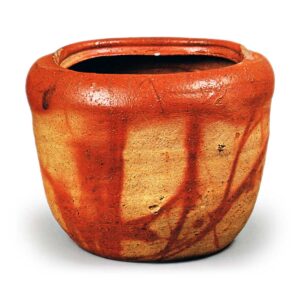
Unglazed pottery with a reddish mottled color in the shape of bars. The oldest examples are the cups and plates of Nara period Sue ware from the Heijo Palace site and the Shosoin Repository. Brown or light brown streaks remain on a gray ground. It is thought that straw was placed between the layers of pottery when they were fired. Bizen Ibe ware is said to have had fire sticks since the Tensho period (1573-92) in Kobizen. According to the “History of Ceramics in Japan,” “hiboki-ware was produced when salt was thrown into an empty bale with firewood when firing in a kiln and the salty medicine attached to the ware, and the pattern was irregular and had its own taste, However, only this artificial material is generally white clay. During the Tempo period (1830-44), Ina Chozo, the second generation of the Tokoname family in Owari, also fired white clay ware by wrapping salt straw around it. For alkaline clay, fire is produced by wrapping only the medicine around the clay without soaking the straw in salt. For acid clay, salty straw must be wrapped around the clay to make a fire stick. Urchin rice straw, glutinous rice leaves, barley, and wheat all produce different types of firewood. It is better to soak them in bitter potassium than salt.



